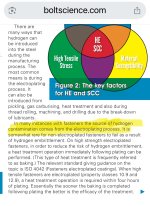Install the app
How to install the app on iOS
Follow along with the video below to see how to install our site as a web app on your home screen.
Note: This feature may not be available in some browsers.
You are using an out of date browser. It may not display this or other websites correctly.
You should upgrade or use an alternative browser.
You should upgrade or use an alternative browser.
Replace that bolt???
- Thread starter TRS
- Start date
The flange head bolt is a M10x1.5x40
Class 10.9
The bolts have failed on the ‘19-‘24.
The ‘25+ have the two bolt mount.
I have been searching for a better option.
I recommend using a stock replacement for now.
10.9 and 12.9 class bolts have an issue with zinc electroplating.
Class 10.9
The bolts have failed on the ‘19-‘24.
The ‘25+ have the two bolt mount.
I have been searching for a better option.
I recommend using a stock replacement for now.
10.9 and 12.9 class bolts have an issue with zinc electroplating.
Last edited:
That was an interesting read. I've heard before you shouldn't use a top-grade bolt where it's not needed, but didn't realize it could be more likely to fail in some circumstances. Bummer that you can't just drop an ARP bolt in there. Hopefully periodic replacement with the Polaris bolt prevents this kind of failure. I've gotta wonder if this is another cost-cutting problem and a bolt from a top-tier supplier would prevent it to begin with - the article mentions that plating and heat-treating processes (part of what makes high-grade fasteners stronger) contribute to the problem when not carefully done. That probably gets short-changed with a low-cost supplier. Hopefully there's a permanent solution out there - great "heads up."The flange head bolt is a M10x1.5x40
Class 10.9
The bolts have failed on the ‘19-‘24.
The ‘25+ have the two bolt mount.
I have been searching for a better option.
I recommend using a stock replacement for now.
10.9 and 12.9 class bolts have an issue with zinc electroplating.
Last edited:
F
FlynHigh
Well-known member
I would think a company like ARP would tightly control the heat treating process, and all manufacturing steps for that matter considering they cost around $4 a bolt.That was an interesting read. I've heard before you shouldn't use a top-grade bolt where it's not needed, but didn't realize it could be more likely to fail in some circumstances. Bummer that you can't just drop an ARP bolt in there. Hopefully periodic replacement with the Polaris bolt prevents this kind of failure. I've gotta wonder if this is another cost-cutting problem and a bolt from a top-tier supplier would prevent it to begin with - the article mentions that plating and heat-treating processes (part of what makes high-grade fasteners stronger) contribute to the problem when not carefully done. That probably gets short-changed with a low-cost supplier. Hopefully there's a permanent solution out there - great "heads up."
Per the article hydrogen embrittlement is generally associated with the electroplating process. All the ARP bolts I have bought have been black in color so I don’t think they are electroplated but need to verify.
Attachments
I tig welded a piece of aluminum to the side of the stock mount.
Drilled it out and tapped the bulk head and used an allen head bolt.
Now using two bolts and no issues in a full season.
I had previously broke two stock bolts.
Drilled it out and tapped the bulk head and used an allen head bolt.
Now using two bolts and no issues in a full season.
I had previously broke two stock bolts.
Yup, I've got to wonder - if the bolt in question was the same type and rating, but made to ARP's standards, would this be happening? Might be the result of a low-cost supplier cutting corners. I've bought a dozen or more ARP bolt sets (mostly black, some stainless) and never broken one. It seems their 8740 chrom-moly fasteners are black oxide coated. I have no idea if embrittlement isn't a problem with that process, or if they can prevent it. Either way, they obviously know what they're doing.I would think a company like ARP would tightly control the heat treating process, and all manufacturing steps for that matter considering they cost around $4 a bolt.
Per the article hydrogen embrittlement is generally associated with the electroplating process. All the ARP bolts I have bought have been black in color so I don’t think they are electroplated but need to verify.
Similar threads
D
- Replies
- 0
- Views
- 419
D




